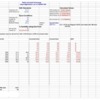During my time on the this forum over the past several months, I've read lots of great information on different engine sizes and even specific engine builders.
As such, it's got me curious if anyone knows about the engines installed by Thunder Ranch. My TR Spyder was built in 2011, and here's a link from BAT when it went up for sale a year before I purchased it -- contains lots of photos of the motor: https://bringatrailer.com/list...955-porsche-550a-13/
Did TR have an outside, preferred engine builder? Or, were they built in-house? Any information would be greatly appreciated.
Thanks!




 ) think big, evil laugh here! , or anything in between, depending on the parts in it. When floored in 3rd gear, how high will it rev to WITH POWER? It will go 500 or even close to 1,000 rpm higher, but you'll have felt the acceleration fall off just a little bit, and that's the engine's redline.
) think big, evil laugh here! , or anything in between, depending on the parts in it. When floored in 3rd gear, how high will it rev to WITH POWER? It will go 500 or even close to 1,000 rpm higher, but you'll have felt the acceleration fall off just a little bit, and that's the engine's redline.

































